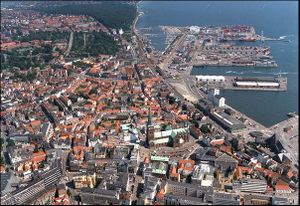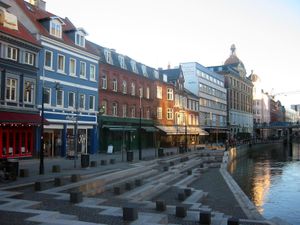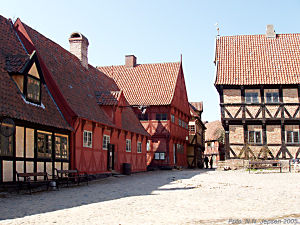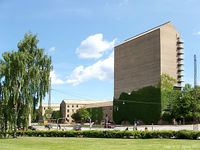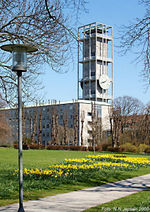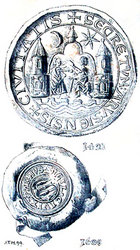Aarhus
2007 Schools Wikipedia Selection. Related subjects: European Geography
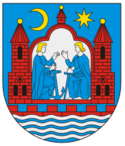 |
|
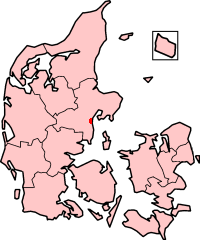
|
|
| Population (2006-01-03) - City - Metropolitan - Density (city/met) |
296,368 Århus municipality: 468 km² urban area 739,013. 5060 km² eastern part of region midtjylland 1 jan 2007 |
| Time zone | Central European: UTC+1 |
| Latitude Longitude |
56°09' N 10°13' E |
Aarhus ( Danish pronunciation ) also commonly known by its contemporary Danish spelling Århus, is the second largest city and the principal port of Denmark situated on the peninsula of Jutland. Aarhus is the seat of the council of both Aarhus municipality and Aarhus County and claims the unofficial title "Capital of Jutland".
Demographics
Aarhus city holds almost 300.000 citizens, but within a 30 minute drive, there are around 700.000 inhabitants making it the second most populated area in Denmark after the Copenhagen area. Aarhus will be a part of the new Region Midtjylland beginning 01 Jan 2007. Aarhus is the largest city in the region and will be the natural economic and cultural focal point of the area. The new region will hold 1,219,741 inhabitants and Aarhus is expected to change a lot in the coming years because of the influx of people moving to the city from surrounding areas. Aarhus has issued a highrise policy for the city to accommodate new apartments being built for the many new inhabitants. Already about 70 highrises, 10 stories and higher are being planned, and plans for many more are under way. Aarhus is the fastest growing city in Denmark, with approximately 2,500 new inhabitants every year. In 1980, the city had 245,000 inhabitants. Today that number nearly surpasses 300,000. The built up area around Aarhus is more or less from Skanderborg in the south to Studstrup in the north - about 40 km from north to south.
Geography
The city lies roughly in the geographical centre of the kingdom on the relatively sparsely populated peninsula of Jutland with large natural areas and preserves nearby. Forests expand from the south into the city within just a kilometre of the city centre. The city is practically built around the harbour which is predominantly industrial, although a large recreational marina is situated south of it as an extension.
While some of the highest points of Denmark are close to the city, the general landscape is typically flat with large swathes of farmland interspersed with forests and meadows. The coastline consists mostly of sandy beaches, but stony areas are not uncommon. The immediate coastal regions are not heavily populated due to a national policy of keeping residences inland rather than crowding the coast.
The city lies at the junction of railway lines from all parts of the country in a low-lying, fertile, and well-wooded district. To the southwest (about 21 km by rail), sits a picturesque region that contains the Gudenå. Several larger lakes extend west from the railway junction of Skanderborg and rise to heights exceeding 152 metres in the Himmelbjerget. The railway traverses this pleasant district of moorland and woodland to Silkeborg, a modern town in one of the most attractive areas in the kingdom.
Culture
Aarhus is a centre for education on the peninsula of Jutland drawing students from a large area, especially from the western and southern parts of the peninsula. The relatively large influx of young people and students creates a natural base for cultural activities and there are many cafes - around 500 in the city - as well as discoteques, cinemas, museums, amusement parks and various other venues of entertainment. Each year the town hosts several festivals and concerts including Aarhus International Jazz Festival and Aarhus Festuge the biggest festival in Scandinavia.
One major tourist attraction in Aarhus is The Old Town ( Danish: Den Gamle By), which is not actually an old part of the city itself, but a collection of historic Danish buildings gathered from all around the country. The old town was recently ranked one of the 3 best tourist attractions in Denmark in the same category as Tivoli and Legoland. The city also hosts the Tivoli Friheden amusement park as well as the Deer Park situated in the large nearby public forest.
Architecturally impressive sights include the 13th century cathedral in the centre of the city; Århus Domkirke is the tallest cathedral in Denmark, as well as the second tallest in Northern Europe, being only 1.5 ft shorter than its counterpart in Trondheim. The Aarhus City Hall is a uniquely designed building drawn by renowned architect Arne Jacobsen, located in the city centre. The city hall is included in the national educational canon for culture as an example of important architectural work.
There are many museums scattered around the city with ARoS being the newest and largest featuring daily exhibits of contemporary art. Other museums include Aarhus kunstbygning also featuring mostly contemporary art, Frihedsmuseet focusing on the occupation and resistance movement during World War II and Kvindemuseet mainly showcasing feminist history and culture.
Being a comparably large Danish city, Aarhus has received a fair share of immigrants from various other cultures and is as such also home to one of the few ghettos in Denmark, Gellerup. The international cultures present in the community are an obvious and visible part of the city's daily life and contribute to many cultural flavours uncommon for the North, such as the Arabic themed Bazar West, a market with shopkeepers predominantly of foreign descent.
The city has an active and visible gay and lesbian community which the city officially attempts to promote and nurture. The Aarhus Festuge festival usually includes several exhibits, concerts or events specifically designed for these communities. There are several clubs, discos and cafes aimed at gays and lesbians: Danish D-lite (sports), Diskotek Blender (disco) or Gaia Vandreklub (hiking club) are a few examples. The mood in the city is generally relaxed towards group minorities of varying persuasions and safety and security is generally very good.
It is common for tourist brochures and local politicians to refer to the town with the tongue-in-cheek slogan "The worlds smallest big city" reflecting the fact that the city has everything a city needs while unquestionably not a metropolis. Another popular, and perhaps better known phrase to describe the city, is "City of Smiles" - a slogan first coined by the city council in the 1930s as an advertising slogan, and which subsequently is used widely in popular culture today.
Sports
In the southern-Aarhus Marselisborg Park, the sports centre named Atletion is located, comprising of athletics and football NRGi Park and indoor sports NRGi Arena. Several sport clubs have their home ground in Atletion, including Aarhus Gymnastik Forening, the top league football team, and Aarhus GF handball team, the 1960 European Cup runner-up.
Aarhus (and especially Atletion) has served or will serve as the host of many sport events in recents years including:
- 2002 European Women's Handball Championship
- 2005 European Table Tennis Championships
- Denmark Open in badminton
- UCI Women's Road Cycling World Cup
- 2006 World Orienteering Championships
- 2006 World Artistic Gymnastics Championships
- GF World Cup; the world's largest handball tournament for women
- dancesport IDSF World Standard 2006
Education
The town is home to the University of Aarhus, Aarhus School of Business, Aarhus Technical College and the University College of Aarhus and several other high-end educational centres. It is possible to receive higher educational levels within many areas, from engineering and dentistry to language and theology. The educational institutions are key elements of the social life of the city and play a large role in many cultural events throughout the year.
The University of Aarhus is divided into 5 faculties: Humanities, Health Sciences, Social Sciences, Theology and Science. There are at any given time approximately 40.000 students in city and 21,000 students at the university with approx. 5,000 new students per year. Every year the university educates some 2,000 masters and another 2,000 bachelors.
Politics
The city council consists of 31 members elected for 4-year terms. Anybody eligible to vote and residing in Aarhus municipality can run for a seat on the city council. After elections have determined the members of the city council, the council elects a mayor, 2 deputy mayors and 5 councilmen. The current Mayor of Aarhus is Nicolai Wammen of the Social Democrats elected by the city council after the 2005 municipal elections.
The city is divided into 6 minor administrative bodies which together constitute the magistrate led by the mayor and the 5 elected councilmen as political and administrative directors. The 6 magistrate departments of the city are the “Mayor’s Magistrate”, “Social and Employment Magistrate”, “Technology and Environment Magistrate”, “Health and Social Magistrate”, “Culture and Service Magistrate” and “Children and Youth Magistrate” and handle all the day-to-day operations of the city.
City council meetings are held every second week and the first part of the meetings are usually open for interested observers, be it tourists or locals. The second part is usually closed for spectators. Aarhus is also the seat of Aarhus Municipality and Aarhus County which arguably gives the city some control over a sizable area of its surroundings.
Industry and business
The harbour is one of the largest industrial harbours in northern Europe and the largest in Denmark. The facilities are very modern and handle some 10.000.000 tons of cargo per year. Much agricultural produce is exported, while coal and iron are among the chief imports. The harbour itself is maintained by Århus Stevedore Kompagni A/S originally based in Aarhus but currently operating several harbours around the world.
The region is a major producer of agricultural products with many large farms in the outlying districts. Cattle, pork and grain are the main products with a sizable related refinement industry present. Computer and technology heavy industries are mainly focused in the urban areas with an abundance of small and medium sized IT and service companies dotting the city centre.
The Ceres Brewery, part of Royal Unibrew, is based in Aarhus and was originally founded here as well. It is a well-known Danish beer brand exported mainly to Germany, Poland and the United Kingdom.
History
The town is relatively old. The bishopric dates back at least from 951, and archaeological findings date back some 1300 years to viking times. The city itself is presumably older than 770 AD, making Aarhus the oldest big city in Scandinavia. The favorable central position of the city within Denmark afforded it trade from Germany, the Baltic countries, the greater peninsula of Jutland and the communities on the many smaller islands in its vicinity, which meant that trade always had a great significance to the town - a significance which is still true today.
The city didn't outgrow Randers until the late 1800s and Aalborg remained the largest city on the peninsula until the 1920s. The relatively fast, albeit late, growth of the city can be ascribed to the general tendencies of moving from rural to urban areas during the industrial revolution. Industrialisation meant that proximity to trade routes became more important giving the harbour city some advantages over other nearby cities as new industries came into existence.
The name
In medieval times, the city was called Arus, and in Icelandic chronicles, it was known as Áróss. It is a compound of the two words ār, genitive of ā "river" (Modern Danish å) and ōss "mouth" (obsolete in Modern Danish; in Modern Icelandic this word is still used for "river delta"). The city is located on the mouth of the small river, Århus Å.
Through regular sound development, Medieval Danish Arus became Aars or Oes, a form which persisted in the dialects of the surrounding parishes until the 20th century. In 1406 Aarhus became prevalent in the written sources, and gradually became the norm in the 17th century. Aarhus is probably a remodelling after the numerous Low German place names in -husen, possibly as a result of the influence of German merchants.
The city is mentioned the first time by Adam of Bremen who mentions that "Reginbrand, bishop of the church of Aarhus (Harusam)" participates in a church meeting in the city of Ingelham in Germany.
Viking times
The oldest archaeological findings in Aarhus are glass pearls which date to the end of the 7th century. Half buried Long houses, used both as homes and workshops for the Vikings have also been found.In the houses and the adjoining archaeological layers, combs, jewelry and basic multi-purpose tools have been found that indicate the settlement is from approximately year 900. Digs in the spring of 2005 revealed a so-called city-ditch from the year 850 which might have marked the trade centre upon which the city is built.
The finding of six rune stones in and around Aarhus indicates the city had some significance around year 1000 as only wealthy nobles traditionally used them.
1600-1700
During the wars of the 17th century, it is probable that the city suffered a great deal. Fortifications still exist south of the city as a reminder of the German imperial campaigns between 1627 and 1629. In 1644, Sweden taxed the city harshly and between 1657 and 1659, it was occupied by Swedish troops on several occasions.
In spite of these and other misfortunes, such as plague and city-wide fires, Aarhus was still quite a significant city in Denmark due to its favourable geographical position which was of significant importance for trading. Trade came mainly from the inland of Jutland but also from Norway, Lübeck, Amsterdam, England, France and Spain. In the middle of the 18th century the trade fleet consisted of approximately 100 ships.
1800
In the 19th century, the city gained more independence from the dominance of Copenhagen and Hamburg. While it had been the third largest city in Jutland during the early 19th century, its population surpassed Randers in 1840 and in 1850, Ålborg, thus becoming the largest city in Jutland and the second largest in Denmark.
The city's material prosperity continued to increase as the harbour expanded and the railway network grew. Culturally, it marketed itself as the "Capital of Jutland" and expanded many of its cultural institutions like the national library, universities, the Aarhus Theatre and hospitals.
Sights and landmarks
- Århus Domkirke Tallest cathedral in Denmark'
- Church of Our Lady Large church in Århus
- Århus City Hall City Hall of Århus
- Aarhus Universitet University of Århus
- Statsbiblioteket State library
- The Old Town Open air museum
- Det Jyske Musikkonservatorium The Jut music conservatory
- Botanisk Have Botanical garden
- Tivoli Friheden Amusement park
- ARoS Aarhus Kunstmuseum The main Århus arts museum
- Aarhus kunstbygning Århus arts museum
- Marselisborg Slot The royal castle of Århus
- Århus Teater Official theatre of Århus
- Musikhuset Music and theatre scene
- Dyrehaven Open air park with deers and wild boar enclosures
- Telecommunication Tower Arhus Concrete tower with guyed mast on its top
- Skejby Sygehus 'The second largest hospital in Denmark
- Atletion Combinated sport venue
Famous Aarhusians
- Ole Rømer
- Jens Christian Skou
- Bjarne Stroustrup
- Ole Worm
- Lene Hau
- Steffen Brandt
- Flemming Povlsen
- Marc Rieper
- Camilla Martin
- Kaare Norge
- Tina Dico
- Nicklas Clausen
